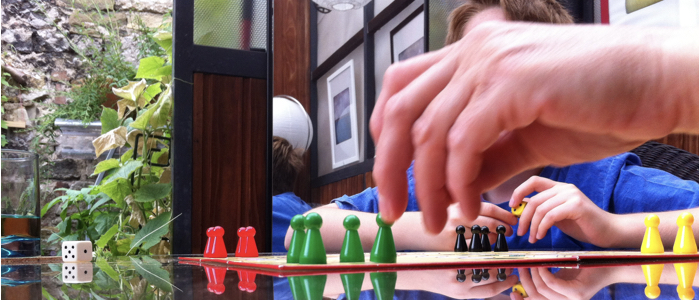Markus Engstler
Corpora non agunt nisi fixata ...

Lehrstuhl für Zell- und Entwicklungsbiologie
Theodor-Boveri-Institut
Biozentrum der Universität Würzburg
Am Hubland
97074 Würzburg
Markus Engstler
... is a molecular cell biologist with substantial interest in infection biology and (bio)physics. He graduated from Christian Albrecht University of Kiel where he also received a doctorate in biochemistry. Markus spent his postdoctoral time at The Rockefeller University (New York) and the Max Planck Institute of Biochemistry (Martinsried). He further developed his quantitative approaches to study cells as a project group leader at the Free University of Berlin and the Ludwig Maximilian University of Munich. Following habilitation in Genetics (LMU Munich), he was appointed Professor of Genetics at Darmstadt University of Technology. Since 2009, Markus Engstler is Professor and Chair of the Department of Cell and Developmental Biology at the Julius-Maximilians-University of Würzburg. Among other duties, he continues to act as a member of numerous scientific advisory boards, as well as an editor for several journals. He has served as dean and vice-dean of faculty, and is founding director of the Center for Computational and Theoretical Biology (CCTB). Markus Engstler is also a founding member of DNTDs, the German Network Against Neglected Tropical Diseases. He is acting president of the German Society for Parasitology (DGP) and serves on the board of directors of the German Life Sciences Association (VBIO.) Recently he has initiated and co-founded the German Center for Multisectorial Fight against Neglected Tropical Diseases (DZVT). Since 2021, Markus Engstler is speaker of the new DFG priority programme SPP 2332 "Physics of Parasitism". He is currently also Dean of Studies at the Faculty of Biology in Würzburg and was awarded the Memento Research Prize 2022 for Neglected Diseases.
since 2009 Chair and Professor of Cell and Developmental Biology, University of Würzburg
2006 - 2009 Professor of Genetics, Technical University, Darmstadt
2004 Habilitation, LMU Munich
2001-2004 Research Project Leader, LMU Munich
1998-2001 Senior Staff Scientist, Free University of Berlin
1996-1998 Postdoc, MPI Martinsried
1994-1996 Postdoc, The Rockefeller University, New York
1994-1999 DKFZ postdoctoral fellow
1994 Dr. rer. nat, University of Kiel
Research synopsis
We have been using African trypanosomes as a cell biology model for 30 years. Early biochemical work unraveled trans-sialylation, a novel mechanism of protein glycosylation, which was later shown to be critically involved in pathogenesis. Research on the control of parasite development led to new paradigms for the molecular basis of trypanosome stage differentiation. Cold-shock and chemical sensing function cooperatively in the initiation of stage transition and the routing of the major surface coat proteins is differentially regulated throughout the parasite’s life cycle. The characterization and mapping of the endocytic recycling pathways in T. brucei using quantitative fluorescence and EM methods has paved the way for trypanosomes to become a more generally accepted model system. The kinetics of plasma membrane recycling is extremely fast and the parasites harbour morphologically and functionally well-defined endosomes. A novel mechanism for the sorting of GPI-anchored proteins appears to be present (not only) in trypanosomes. This work also suggested that rapid endocytosis could be essential for trypanosome survival. The parasites continuously swim and thereby generate directional flow fields on their cell surface. These flow forces become functional when the surface coat, which is dominated by variant surface glycoproteins (VSG), is attacked by host immunoglobulins. Hydrodynamic forces drag antibody-VSG complexes towards the rear of the cell, where they are endocytosed. Thus, pure physical forces can sort proteins in the plane of the plasma membrane.
Antibody clearance raised the question how trypanosomes actually swim and if this phenomenon is functional in natural infection. This could only be addressed in collaboration with partners in Africa on the one hand, and physicists and mathematicians on the other hand. Trypanosomes reveal an amazingly complex motion behaviour in vitro and in the diverse and crowded environments of the host. Different trypanosome species have adapted to distinct infection niches, such as the circulation or tissue spaces. And the parasites not only swim in the mammal, but also in the insect vector, where they form giant swarms.
Most recent work unraveled that trypanosomes are dynamic at various scales: the first complete structures of VSGs revealed an unprecedented molecular flexibility that accounts for different populations of VSGs on the cell surface of trypanosomes diffusing at different rates. Overcrowding of the VSG coat leads to rapid formation of nanotubes and nanovesicles that - by purely physical forces - are shed form the cell surface.
Thus, part our work will continue focussing on the mechanical forces acting within, on and around different trypanosome species. The latest idea that we plan to test is that mechanical adaptations allow avoidance of interspecies competition in the same host. This study is Project 4 of the SPP 2332 PoP.






